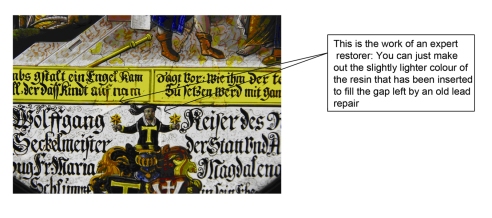Glass fractures are one of the most common forms of damage found in stained glass panels. There are many different ways in which fractures can be repaired, all of which have pros and cons. Below is a selection of tried and tested methods that have been used to repair broken glass:
Repair Leads
The section of painted glass below was severely damaged at some point in it’s history – perhaps by a stone thrown into the window. The glass shattered into many small sections and yet the glaziers commissioned with the repair decided to keep the glass and repair the damage rather than replace the whole section. To replace a large piece of mouthblown red glass would simply have cost too much. Instead, the glaziers dismantled the whole panel and re-leaded it, incorporating the broken section into the lead network. They would have had to reduce each glass piece by a few millimetres to accommodate the lead. This has caused irreversible damage to the panel.

Repairs using lead are very durable but they interfere with the image and the original design. In order to fit them, the edge of each glass piece has to be grozed – this is irreversible and therefore not something a conservator would do today.
Strap Leads
Strap leads are a good alternative to inserting a whole lead as they are more reversible. A strip of lead is placed across the fracture and soldered to the surrounding leads and puttied into place. Strap leads can provide good support to broken glass but they also interfere with the image and the design of a window. The repair is usually very durable but can become weak, especially if the putty has become dry and crumbly. The putty applied to the glass surface can damage the paintwork – as it dries it shrinks and if it is well adhered it can pull away part of the paint.

Adhesives
Repairs using modern adhesives such as epoxy resins can produce aesthetically pleasing repairs which are far less noticeable than a repair- or strap lead. Resins can be tinted to match the glass colour and they can be formulated to have a similar refractive index to glass. In the hands of an expert restorer the result can be an almost invisible repair. Resins were introduced to glass conservators around 1975.
At the Burrell there are a number of excellent examples on display:




For many years resins were extensively used to repair broken glass and the aim of this kind of restoration treatment was to improve the appearance of stained glass and to “restore it to it’s former glory”. However there are increasing concerns about issues surrounding durability, aging characteristics and reversibility. 30 years down the line we are seeing many resins yellowing and also becoming brittle and failing.
The Venetian Tazza, or cup, below was repaired with a resin called Ablebond in 1987. Ablebond was also used a lot in stained glass conservation. The resin produced a good finish when first used but has become dry and brittle over time, and degraded to the point where the bond failed completely.

The remaining resin was removed so the cup could be conserved, and was found to be very yellowed and brittle (see image below).

Here is an example of stained glass where old repair leads were replaced with resin 26 years ago:

These repairs were not so successful – the stained glass was very badly damaged already and there were many losses (including those that had been caused by grozing the edges of the glass to fit the repair leads). A lot of resin had to be used to infill the gaps and over 26 years the resin has yellowed and become brittle. The whole treatment will have to be redone in the coming years.
As part of the Boppard Project we have considered alternative options alongside these for repairing or consolidating glass fractures. We have tested a couple of methods, based on their potential for providing support with minimal intervention and ease of reversibility, inspired by techniques seen in other studios and conservation disciplines. We will be looking at these in more detail in our next blog.